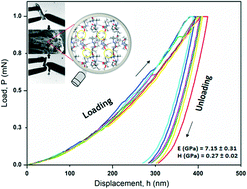Structure–mechanical property relationship of a pentapeptide crystal†
Abstract
The structure–mechanical property relationship of a synthetic pentapeptide crystal containing coded and non-coded amino acids was presented. Pentapeptide 1 has two α-aminoisobutyric acid (Aib) residues at 2 and 4 positions and formed an orthorhombic crystal, with the space group P212121, which is sensitive to external stress and brittle in nature. From FE-SEM the crystal appears as a thick bundle of several fibers. The structural analysis of a crystal of pentapeptide 1 obtained in methanol–water confirmed the existence of an unusual secondary structure, a miniature (P)310/α-helix. The pentapeptide 1 molecules self-assemble by intermolecular N–H⋯O hydrogen bonds and form a supramolecular helical bundle structure which further assembles to form a supramolecular sheet-like structure along the crystallographic a and c directions. The intermolecular interaction energies (kJ mol−1) for pentapeptide 1 were calculated using the B3LYP/6-31G(d,p) dispersion corrected DFT model. Although the interaction energy is small, there is no sign of slippage due to the interdigitation of the Leu i-propyl, Boc t-butyl, and Phe side chains. As a result, the crystal is brittle in nature. Moreover, the quantitative nanoindentation technique reveals the moderate E and H values for the major face of this crystal, which is consistent with the presence of adequate van der Waals interactions and several hydrogen bonding interactions in the structure.

- This article is part of the themed collection: Supramolecular & Polymorphism


 Please wait while we load your content...
Please wait while we load your content...